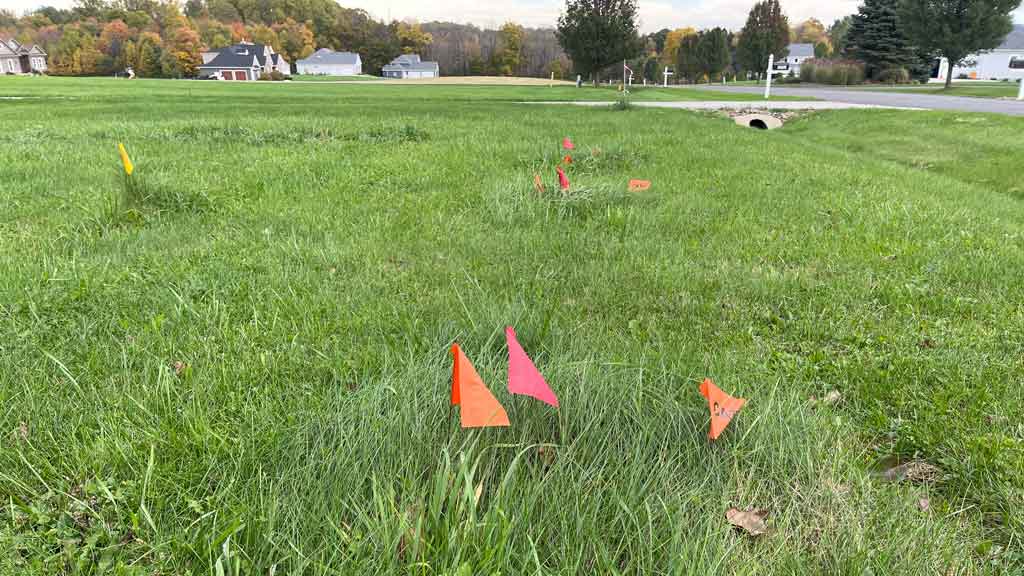Underground utilities are the lines that bring basic utilities to a house or business. Sometimes they are ran overhead on utility poles. Lines that aren’t ran overhead are underground.
Common types of underground utilities consist of electric, gas, telephone, cable and water. However, there are other types too.
It is important to have underground utilities marked before digging. This prevents accidental damage to the lines. As a result causing outages of one or more of your utility services.
It will also help to inform you if there are any utility easements located on your property.
Furthermore, and more importantly, it prevents accidental injury. It is so important to have utility lines marked that every state offers marking services. The nationwide phone number for utility marking services is: Call 811

Underground Utilities Company
There are many companies that mark utility lines. Some are free services and others will charge. The type of utility lines needing marked determine what type of company you should contact.
Public utilities run from the right of way up to where they connect to a home, building or dwelling. As mentioned before, it is a free service to have most public utilities marked.
Private underground utilities are any lines ran from a home, business or dwelling to detached garages, sheds or other structures. Marking private utility lines is not a free service. Therefore, a private utilities locator will need called.
Dial Before You Dig
Call 811 is the national call before you dig number. Calling the number creates a call ticket with information in regards to the project.
The address where the digging will commence, reason for digging, type of equipment used for digging and location on the property are all required.
Creating a ticket notifies all major utility companies in the area. Once notified, utility companies have a set amount of time to respond to the ticket. Normally around 3-4 days.
Some utility companies will send out a representative to check for and mark their lines present. However, many contract private utility losing companies to handle this for them.
Private Utilities Locator
As stated before, calling in a ticket provides you with marking of utilities from the right of way, to the main dwelling on the property.
However, for private utility lines or other types of unmarked buried lines, hire a private utilities locator.
Private utilities locators mark all the lines that Call 811 doesn’t. This includes utilities such as gas, electric and phone lines ran to pools, sheds and garages. However, they also mark other types of lines too.
Communication lines, drain tiles, septic lines and sprinkler lines are all types of private lines. Hitting these types lines while digging won’t lead to injury. However, they can lean to major inconveniences, setbacks and extra expense.
Private underground utilities locators have special equipment that is able to locate these types of lines. Not only are they able to locate the buried lines, often times they let you know how deep they are too.
Therefore, in the event you have privately ran lines, have them marked. The extra cost outweighs lost time in setbacks or expensive repairs.
Utility Marking Colors
There are two methods of marking underground utilities. First, they spray paint the ground where the lines are located. The second method uses small flags to indicate the location of the buried lines.
The paint and flags have very specific colors that correspond to the type of line buried below. Theses colors are standard, used in every state. Below is a list of colors and what they represent.
Yellow – natural gas, oil, steam, petroleum, or other gaseous or flammable material
Blue – potable (drinkable) water
Read – electric power lines, cables, conduit, and lighting cables
Green – sewers and drain lines
Orange – telecommunication, alarm or signal lines, cables, or conduit
Purple – reclaimed water, irrigation, and slurry lines
White – proposed excavation limits or route
Sometimes, no utilities are present in the dig location. In this case, a “Clear” flag marks the location. This informs the person performing the digging that the area is free of any underground utilities. Therefore, safe to dig.
Who Should Call in an Underground Utilities Ticket?
The person responsible for digging is responsible for calling in the dig ticket. Therefore, for contacted projects, the contractors must call for their own ticket. Homeowners and DIYers working on their own projects must also call before digging.
Planning ahead is key. Most states allow 3-4 days for the utility companies to respond to the ticket. So plan ahead and call early. However, don’t call too early. The markings are only good for 10 days.
Marking lines too early leads to problems. Many times related to mowing grass. Grass grows and needs cut. As a result, homeowners or landscapers pull the flags. The paint also fades over time. Snow coveres paint marks in winter months. However, this only happens for projects in northern locations.
Law requires you to renew the ticket if more than ten days have past from the original marking date. Even when the flags and paint are still present.
Conclusion
Having underground utilities is an important step anytime a project requires digging. It is also a step that get’s overlooked or simply ignored by many.
In most states, having public utilities located is a free service. However, locating privately ran lines is not.
It is better to be safe than sorry. Hopefully the location of your project won’t have any utilities located near it. However, when doing projects such as fencing in an entire yard, you can be certain that utilities will come into play at some point.
In some cases, calling in a ticket in the planning stages of a project is helpful. Knowing the location utilities ahead of time prevents unplanned surprises later.
Whatever the reason for your dig, make sure to call 811 first. Doing so protects you and your community form accidental outages or injuries. At the same time, preventing costly repairs.

